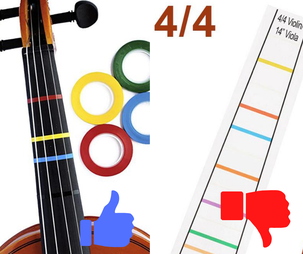Teaching Aids for the Violin
© Goh Tong Keat
|
|
If you have been exploring teaching aids for your violin students, you'll discover a diverse range of tools at your disposal. While I primarily rely on traditional teaching methods, I occasionally find certain aids to be beneficial for students who encounter challenges in specific areas of violin playing. In this article, I will present a selection of tools available in today's market, providing detailed reviews of their functions, usage, and their potential contributions to violin education.
Fingerboard Tape
I believe this is the most common thing that many violin teachers use. The main function of these tapes is to help beginning students to visually identify the spots which they put their fingers on. Keep in mind that this is only a temporary measure at the beginning stages and students must learn to find the notes by ear as soon as possible. Too often students become over relying on these tapes that they failed to develop their listening skills.
When using fingerboard tapes, avoid the one with prefixed intervals for the entire fingerboard but instead mark each spot with individual strip after checking the intonation. I do not believe that the prefixed one will fit all instruments perfectly.
When using fingerboard tapes, avoid the one with prefixed intervals for the entire fingerboard but instead mark each spot with individual strip after checking the intonation. I do not believe that the prefixed one will fit all instruments perfectly.
Bow Hold Helper & Pinky Holder
Another very common tool is the rubber mold that is attached to the bow. Its main function is to help students to develop a good bow hold. Beginning students often grip the bow in a very stiff manner, mainly because they do not feel that they can keep the bow securely in hand. Such tools can help the fingers to remain curved, evenly spaced, and relaxed. There are many types of bow hold helpers available, if you decided to use one, make sure you choose one that resembles closest to a good bow hold.
Pinky Holder is another tool that helps with the bow hold except that it is much simpler. Its purpose is to keep the pinky curved and standing in the right place, a common problem that most students are struggling with.
Pinky Holder is another tool that helps with the bow hold except that it is much simpler. Its purpose is to keep the pinky curved and standing in the right place, a common problem that most students are struggling with.
Wrist Guide & Wrist Rascal
Having a collapsed wrist is a common problem for many students. A wrist guide is like a wrist band that ties to your hand and keeping the wrist straight. A wrist rascal has the same function except that it is tied to the instrument instead of the wrist. Sometimes, collapsed wrist may also be caused by the instrument not being properly supported on the shoulder or the instrument being too heavy. Once again, this tool shall only be a temporary measure until the students gain enough awareness to keep their wrist straight.
Bowing Guide
Bowing guide is a frame with two parallel bars placed across the violin. It helps to keep the bow moving parallel to the bridge. Having the bow to move consistently on a good sounding is the main consideration for a beautiful tone. Hence, this tool may help certain students who are struggling with this aspect of violin playing. I personally find this tool useful for “opening up their ears” to the possibility of playing with good tone. However, learning to bow independently without the tool may still be a challenging task.
Bow Stopper
Bow stopper is a piece of sponge or rubber that is attached to the bow stick, and it prevents students from moving the bow past that point. Some students tend to play with only the upper part of the bow because they are not used to supporting the weight of the bow at the lower half. This prevents the student from developing a good bow technique. Students must learn to control the bow at any part. These bow stoppers, when used in pairs, can also guide the students on which part of the bow to play with for a selected passage of music. As an alternative, tapes can be used on the bow stick to provide visual guides for students on how much bow to use.
Standing Mat
A standing mat serves as a valuable tool in violin learning, providing clear visual guidance for students regarding proper foot placement. Despite its apparent simplicity, this aspect of violin technique is often overlooked, leading to students adopting an imbalanced stance with their feet positioned too closely together. By utilizing a standing mat, we address this crucial element, promoting a balanced and stable posture that enhances both comfort and technique during violin practice and performance.
Foam Violin
A foam violin serves as an ideal introductory tool for babies and toddlers, allowing them to explore the concept of proper violin hold before transitioning to the real instrument. With its soft and safe construction, it provides a child-friendly alternative while preserving the fragility of the violin, making it a suitable choice for young children who have yet to receive formal training. By introducing them to the foam violin at an early age, we can lay the foundation for their musical journey, promoting correct posture and instilling a sense of familiarity and comfort with the instrument before they graduate to the real thing.







